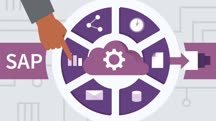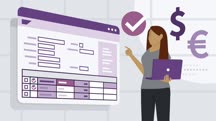Course catalog
Categories
Showing 1,201-1,220 of 1,450 items.
SAP BPC Embedded Fundamentals for Planning Applications (225315)
If you’re an SAP developer or ABAP programmer looking to expand your skills into SAP BI-IP or BPC Embedded, this course is for you. Learn to design, configure, and roll out a complete planning application inside SAP BPC embedded or BI-IP. The course starts with the design of a simple planning action to familiarize you with the basic functionality and terminology available in BI-IP, before drilling down into more complex functionality to enable you to design more advanced planning applications. This course also helps you understand the various options for reporting and planning within the Embedded/BI-IP environment, and goes over how to create and maintain planning functions in BI-IP and Embedded.
Note: This course was created by Michael Management. We are pleased to host this training in our library
Note: This course was created by Michael Management. We are pleased to host this training in our library
SAP Business One Essential Training (218804)
Do you need a better way to manage the data you use for customer relationships, finances, and more? In this course, instructor Steven Lipton introduces you to SAP Business One (SAP B1), an ERP suite for small businesses. SAP B1 is a full data-management solution for everything from Sales, Purchasing, Finance, Inventory and production management. Steven explores the most popular ways businesses are using SAP B1, including essential modules, powerful user functions, reporting, customization, and more.
SAP Business One: Production and Logistics (230177)
If you’re running any sort of manufacturing, distribution, or retail operation, keeping track of what goes in and out the door is vital to your business. In this course, instructor Steven Lipton dives into the production and logistics module of SAP Business One and shows how it functions as an accounting module for tracking goods and materials, as well as an inventory module to help with procurement and inventory management systems. Steve covers how to track inventory in one or more warehouses, how to remove items from inventory after a sale, and how to purchase goods and enter them into inventory. He also goes over production workflows by taking raw materials and turning them into finished goods, tracking them through purchasing, storage, manufacturing, and shipping. He also details how to purchase future inventory and supplies using MRP in Business One.
SAP Business Rule Framework (BRF+) Introduction (234801)
This course covers the basics of the SAP in-house Rapid Application Development tool, Business Rule Framework (BRF+). The course starts with the basics of Rapid Application Development (RAD), then provides an introduction to the concepts and strengths of BRF+. Also covered are the differences between waterfall and agile project management, and details on how to integrate BRF+ into each workflow.
Note: This course was created by Michael Management. We are pleased to host this training in our library
Note: This course was created by Michael Management. We are pleased to host this training in our library
SAP ERP Essential Training (217648)
The SAP Enterprise Resource Planning (ERP) platform helps large organizations streamline their processes across each segment of their business, from sales to financial accounting. In this course, instructor Justin Valley covers key concepts within SAP ERP and shares valuable tips to help you use this enterprise software most effectively. Justin explains the difference between master data and transactional data in SAP before diving into commonly used SAP modules, including SAP Materials Management (MM) and SAP Sales and Distribution (SD). He also shows how end users can navigate inside SAP, use various search methods to find data, run and export reports from SAP, and more.
SAP Financials Essential Training (216713)
In this course, instructor Justin Valley dives into the financial accounting module of SAP FI ERP. Justin covers the general ledger, accounts receivable, accounts payable, and asset accounting submodules. After going over the general ledger and SAP FI integration, Justin discusses SAP financials master data, company codes, reconciliation accounts, and more. He goes into the general ledger in more depth, then describes the transactions and reports you can access through accounts payable and accounts receivable. Justin gives you an overview of asset accounting and goes on to describe creating asset master records, acquiring an asset, posting unplanned asset depreciation, and more.
SAP SuccessFactors Performance and Goals Management (230568)
If you are an HR professional or an IT professional supporting HR, you know how important it is to measure how well employees do their job and meet their own and the company’s goals. This course from Michael Management shows you how the SuccessFactors solution from SAP supports performance and goal management processes and how you can configure and use SuccessFactors. The course explains how the SAP SuccessFactors solution supports the HR process and then steps through basic configuration, including how to set up continuous performance management, route map configuration, configure a performance form template, and much more. The course covers the workflows for day-to-day administration of SuccessFactors, then goes into the goals management panel and workflows. Continuous performance management is the next topic of discussion, then the course concludes by going over other related topics, such as permissions, versions, and releases.
Note: This course was created by Michael Management. We are pleased to host this training in our library.
Note: This course was created by Michael Management. We are pleased to host this training in our library.
SAS® 9.4 Cert Prep: Part 01 SAS Programming Essentials (230653)
Want to get ahead in a crowded job market? Get certified with SAS. This course is the first in a series by the SAS Institute, designed to prepare you for the SAS 9.4 certification exam. Learn SAS programming essentials to handle the most common data-processing tasks with SAS code. Instructor Stacey Syphus explores the programming tools, SAS Studio and SAS Enterprise Guide, along with the structure and syntax of a typical SAS program. She also provides three hands-on demos and shows how to find and resolve errors in your code—a key task for SAS programmers.
This course was created by SAS Institute. We are pleased to offer this training in our library.

This course was created by SAS Institute. We are pleased to offer this training in our library.

SAS® 9.4 Cert Prep: Part 02 Accessing Data (234478)
Want to get ahead in a crowded job market? Get certified with SAS. This course is part of a series by the SAS Institute, designed to prepare you for the SAS 9.4 certification exam. Here, instructor Stacey Syphus helps you understand the first step in the SAS programming process: reading and accessing data in a variety of locations and formats. Learn how to identify the features of SAS tables, access data through libraries, and import unstructured and structured data into SAS for analysis.
This course was created by SAS Institute. We are pleased to offer this training in our library.

This course was created by SAS Institute. We are pleased to offer this training in our library.

SAS® 9.4 Cert Prep: Part 03 Exploring and Validating Data (230670)
Want to get ahead in a crowded job market? Get certified with SAS. This course is part of a series by the SAS Institute, designed to prepare you for the SAS 9.4 certification exam. One of the most important steps to take with your data is knowing how to find and format it in a useful way. The following videos introduces you to the ways that SAS can help you explore your data. Instructor Stacey Syphus explains how to use procedures, filter rows with the WHERE statement, create and use macro variables, format columns, sort data, and remove duplicates.
This course was created by SAS Institute. We are pleased to offer this training in our library.

This course was created by SAS Institute. We are pleased to offer this training in our library.

SAS® 9.4 Cert Prep: Part 06 Exporting Results (228630)
Want to get ahead in a crowded job market? Get certified with SAS. This course is part of a series by the SAS Institute, designed to prepare you for the SAS 9.4 certification. The following videos introduce you to methods that you can use to convert your SAS tables and reports into accessible formats, including CSV, Excel, and PDF. Instructor Stacey Syphus explains how to use the export command to kick off your data output pipeline, use the SAS output delivery system, and export your analysis results into CSV, Excel, PowerPoint, Word, and PDF files.
This course was created by SAS Institute. We are pleased to offer this training in our library.

This course was created by SAS Institute. We are pleased to offer this training in our library.

SAS® 9.4 Cert Prep: Part 08 Controlling Data Step Processing (228443)
Want to get ahead in a crowded job market? Get certified with SAS. This course is part of a series by the SAS Institute, designed to prepare you for the SAS 9.4 certification exam. Here you can explore data processing techniques using the SAS DATA step. Instructor Stacey Syphus provides demos of DATA step processing in action, showing what goes on behind the scenes in SAS. She also shows how to control where and when output is directed to SAS tables.
This course was created by SAS Institute. We are pleased to offer this training in our library.

This course was created by SAS Institute. We are pleased to offer this training in our library.

SAS® 9.4 Cert Prep: Part 09 Summarizing Data (228596)
Want to get ahead in a crowded job market? Get certified with SAS. This course is part of a series by the SAS Institute, designed to prepare you for the SAS 9.4 certification exam. Here you can explore techniques for summarizing data using the SAS DATA step. Instructor Stacey Syphus explains how to alter the behavior of the DATA step to create an accumulating column—also known as a running total—and process data in groups, so that you can perform an action when a group begins or ends.
This course was created by SAS Institute. We are pleased to offer this training in our library.

This course was created by SAS Institute. We are pleased to offer this training in our library.

SAS® 9.4 Cert Prep: Part 10 Manipulating Data with Functions (228409)
Want to get ahead in a crowded job market? Get certified with SAS. This course is part of a series by the SAS Institute, designed to prepare you for the SAS 9.4 certification exam. Here you can explore techniques for transforming data into useable formats with SAS functions. Instructor Stacey Syphus explains how to use functions to modify numeric, date, and character data, and change one data type to another.
This course was created by SAS Institute. We are pleased to offer this training in our library.

This course was created by SAS Institute. We are pleased to offer this training in our library.

SAS® 9.4 Cert Prep: Part 11 Creating and Using Custom Formats (234308)
Want to get ahead in a crowded job market? Get certified with SAS. This course is part of a series by the SAS Institute, designed to prepare you for the SAS 9.4 certification exam. Here you can explore techniques for standardizing your SAS data with custom formats. Instructor Stacey Syphus explains how to format values, use ranges, and create and apply custom formats. Plus, learn how to create custom formats from tables and store custom formats for future use.
This course was created by SAS Institute. We are pleased to offer this training in our library.

This course was created by SAS Institute. We are pleased to offer this training in our library.

SAS® 9.4 Cert Prep: Part 12 Combining Tables (228460)
Want to get ahead in a crowded job market? Get certified with SAS. This course is part of a series by the SAS Institute, designed to prepare you for the SAS 9.4 certification exam. Here you can explore techniques to consolidate your data by combining tables with the SAS DATA step. Instructor Stacey Syphus explains how to concatenate and merge tables and identify matching and nonmatching rows. Plus, learn the difference between a DATA step merge and the PROC SQL join.
This course was created by SAS Institute. We are pleased to offer this training in our library.

This course was created by SAS Institute. We are pleased to offer this training in our library.

SAS® 9.4 Cert Prep: Part 13 Processing Repetitive Code (228613)
Want to get ahead in a crowded job market? Get certified with SAS. This course is part of a series by the SAS Institute, designed to prepare you for the SAS 9.4 certification exam. Here you can learn how to incorporate loops to reduce repetitive code in SAS. Instructor Stacey Syphus explains how to identify which sections of code are being repeated and consolidate it in iterative and conditional DO loops. She also shows how to combine iterative and conditional DO loops to produce more nuanced output.
This course was created by SAS Institute. We are pleased to offer this training in our library.

This course was created by SAS Institute. We are pleased to offer this training in our library.

SAS® 9.4 Cert Prep: Part 14 Restructuring Tables (228426)
Want to get ahead in a crowded job market? Get certified with SAS. This course is part of a series by the SAS Institute, designed to prepare you for the SAS 9.4 certification exam. Here you can learn how to alter the layout of tables by restructuring data. Instructor Stacey Syphus explains how to restructure data with the DATA step and TRANSPOSE procedure and convert tables to both narrow and wide formats.
This course was created by SAS Institute. We are pleased to offer this training in our library.

This course was created by SAS Institute. We are pleased to offer this training in our library.

Scaling Out Using Azure SignalR Service (225230)
Every modern application has some sort of real-time-communication need. With the rise of microservices and serverless, many developers find themselves working with applications that run on multiple servers. Azure SignalR Service can help you scale these applications by allowing users to connect to a central location and enabling other services to send messages to users quickly without worrying about hosting, scalability, and load balancing. Curious about how to use Azure SignalR Service to build real-time applications in the cloud? This course covers what you need to know to get up and running.
Instructor Nertil Poci goes over what SignalR Service is, the need for it, and the features it offers. He explains how to provision SignalR Service instances, implement failover options, and broadcast messages to your users. Plus, Nertil details how to go serverless with SignalR services and integrate your SignalR Service with Azure Event Grid to respond to different events.
Instructor Nertil Poci goes over what SignalR Service is, the need for it, and the features it offers. He explains how to provision SignalR Service instances, implement failover options, and broadcast messages to your users. Plus, Nertil details how to go serverless with SignalR services and integrate your SignalR Service with Azure Event Grid to respond to different events.
Scrollytelling: Creating a One-Page Web Experience (222833)
What is scrollytelling? What can you do with it, and what are some alternatives? In this course, instructor Bill Shander answers these questions and more. Bill begins with a definition and example of scrollytelling, then gives you examples of its benefits for user engagement and narrative experience. He presents some alternative ways to tell stories on your website and offers some pros and cons for each. Bill goes over the technical components of what makes a scrollytelling experience and goes over some options for technologies you can use to create such experiences. He walks you through the complete process of turning your idea into a scrollytelling masterpiece using one particular approach, then concludes with useful advice on cleaning it up to deliver the best possible experience to your users.



















